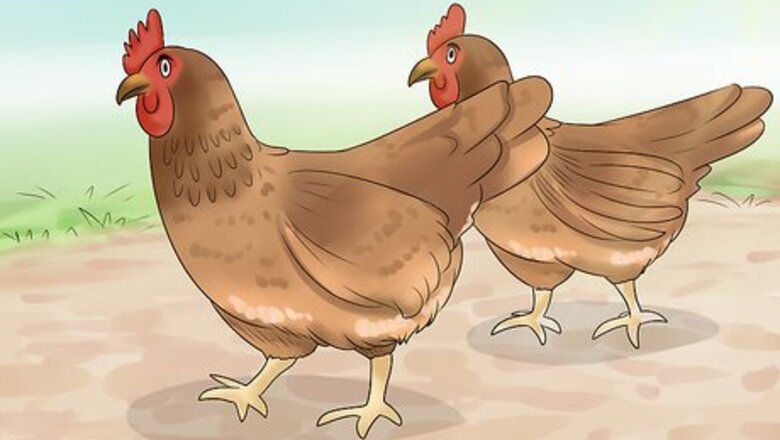
views
Allow your chickens to roam free during the daytime.
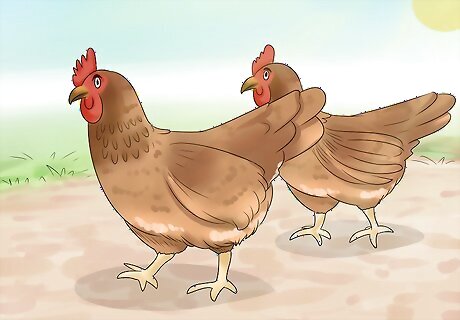
This might train your chickens to come back when it gets dark. If you make it a habit of only letting your chickens out of the coop during the day and providing them with food and water during this time, you can train them to return to their coop at the end of the day. This is when owls begin to prey and the time when your chickens need the most protection. Chickens should always be in their coop from sunset to sunrise. This reinforces the location as their safe-zone. If your coop exceeds temperatures of 21 °C (70 °F), consider installing fans to provide a more comfortable home.
Remove any leftover chicken food or potential owl food each day.

Cleaning discourages predators from hunting near your coop. Stay on top of cleaning your coop's surroundings and keeping the pen free from any scraps of food. Remove owl food such as mice, voles, shrews, and insects. You should also keep an eye out for sick, dying, or dead chickens and remove them from your flock immediately. Make it a habit to remove eggs daily. Try and remove them prior to sunset, which is when owls begin to hunt.
Keep your chickens in a floorless coop for more flexibility.
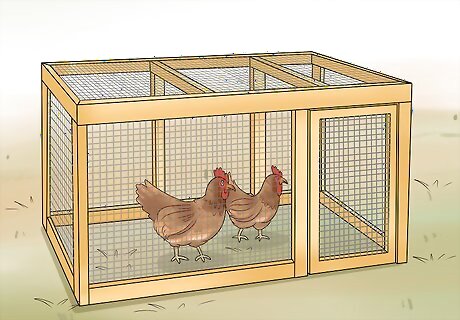
That way, you can move the coop easily if there are predators nearby. These are the simplest kinds of chicken coops and typically consist of a floorless wooden box with some chicken wire around it (some of them also come with a roof). Floorless coops are cheaper and much easier to move than bigger products, which allows you to move your chicken flock regularly, adapting to the new predator locations and perching spots. Use a wire net or tarp to cover floorless coops without a roof. Always keep a lookout for new predator locations by scouting the ground underneath nearby trees for large feathers and regurgitated pellets of bone and hair. Switching chickens to a floorless coop [[requires retraining to establish the coop as their new home.
Set up safety shelters around your yard.
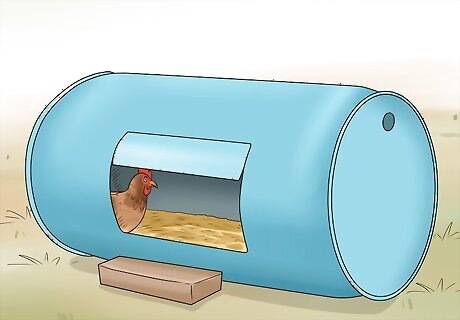
Your chickens can hide if an owl makes an attack during the day. Shelters are ideal for situations when owls make an attack of desperation, as they give your chickens somewhere to hide. For an easy solution, place a 210 L (55-gallon) plastic drum on its side and cut a hole along it that's big enough for chickens to hide in. Fill the shelter with hay to provide comfort. Place 1 brick on each side of the drum to prevent it from rolling.
Cover your chicken coop with protective material.
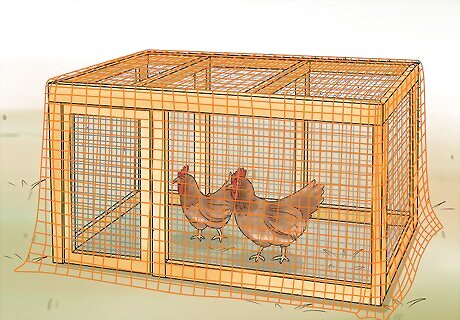
Bird netting materials can prevent owls from getting into your chicken coop. Netting is typically placed over structural openings on your coop and can be attached with bird netting mounting clips. You can also use a tarp sheet if you want to give your chickens some shade. Local hardware or garden stores should stock all of these materials. Be sure to get some measurements from your coop so that you purchase something that is big enough. Use orange netting if possible, as both owls and hawks see this color well. Larger coops usually provide adequate protection for your chickens, making netting unnecessary.
Raise your chickens around ample ground cover.

Bushes and shrubs can provide natural cover from predatory birds. Owls will have a more difficult time trying to attack when your chickens can hide in the branches. If you plant your own ground cover plants, make sure they are varieties that chickens can eat like lavender, rosemary, sage, wormwood, fennel, thyme, nasturtium, and comfrey. Double-check that they are suited to your climate zone. Purchase pH papers online to check if your soil matches optimal pH levels. If it's outside of the recommended range of the plant you're going to grow, use an appropriate adjustment technique. Ground cover also provides shade for your chickens during the hot summer months.
Remove perching sites within 91 metres (299 ft) of your chickens.
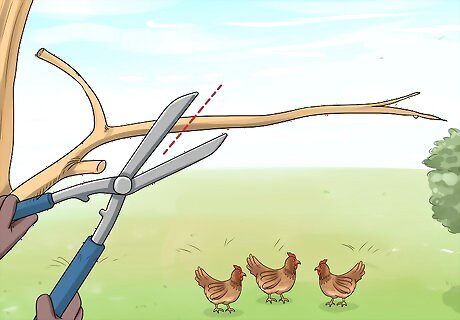
Prune branches and remove any trees that make ideal perching spots. Before you conduct any removal services, make sure that any tree or structure you're removing is on your property. Hire an arborist for anything you are uncomfortable doing on your own. If there are trees on neighboring property that are giving you owl problems, discuss the possibility of removal with your neighbor before taking any action. It can also help to remove any attractive habitat for the prey species such as windfall, wood piles, overgrowth, groundcover, storage and clutter, and standing water.
Place roosting spikes on perching areas 91 metres (299 ft) past your coop.
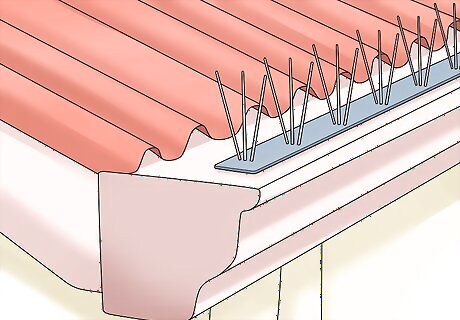
The spikes prevent owls from landing and building nests on them. Roosting spike strips have vertically-positioned spikes that keep birds off of the branches. Owls typically perch in high spots to observe your chickens and plan their method of attack. Take note of any regions that could be used for roosting in proximity of your chicken coop and place roosting spikes on them, such as near rain gutters. Roosting spikes can be purchased online or at local home hardware stores, and are also called "pigeon spikes." Use non-silicone-based outdoor construction glue to apply spikes to steel. You'll need at least 4 number #8 wood screws for every 0.61 m (2-foot) section of spikes installed.
Install an electric fence.
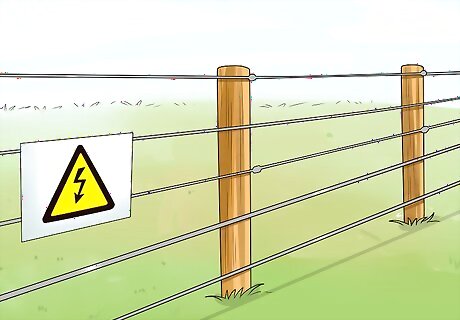
Keep at least 15.24 metres (50.0 ft) between each post. For free range chickens, electric fences are fairly cheap and not too tough to install. Although they are more effective for defending from ground prey, these fences can also prevent owls from attacking. You can attach electric fences to pole shockers, which can prevent owls from perching on any poles close to your chickens.
Purchase an owl or eagle decoy.

Place the decoy near your chicken coop to scare other owls away. Owls are territorial and hunt alone, meaning they avoid other regions that have been claimed. Place decoys of eagles, hawks, or owls near your chicken coop to "claim" the area and scare them away. Decoys can be purchased from local home improvement stores or online suppliers. Place the decoy somewhere not clearly visible to your chickens—such as on top of posts facing away from your coop or yard—as they can generate nervousness and aggression.
Make a scarecrow.

Move the scarecrow around your yard regularly. Scarecrows can be made fairly simply by creating a cross-shaped frame made from a wooden stick attached to a 1.8–2.4 metre (5.9–7.9 ft) stick, garden pole, or rake handle. Afterwards, dress it up and stuff it with hay. Set it up near your chickens and rotate it regularly, moving it between common owl locations. Try rotating it 2 to 3 times a week to make sure that the owl doesn't discover it's not a real person. Purchasing an electric scarecrow from your local home improvement store is another option. These devices shoot water towards any owls that they detect with their movement sensor. Just make sure that the water pressure isn't too strong; otherwise, you can kill owls (which is illegal).
Buy a guard animal to fend off owls.

A rooster is a common choice for a guard animal to protect chickens. If you have 15 or more chickens, investing in 2 to 3 roosters is ideal. Guard dogs are also very effective for deterring predators both at night and during the day. Some regions (especially urban areas) don't allow roosters. Check your local county and city codes for rooster laws. Dog scent alone can be enough to ward off predators.
Set up motion-activated night lights.

Night lights can scare owls away when they’re hunting. Since owls are nocturnal and hunt prey at nighttime, night lights are ideal for keeping them away. Place the nightlight right outside of the coop, but never leave it inside, as this can interfere with the sleep habits of your chickens. Owls are especially adverse to strobe lights, and many owl-specific night lights utilize a red strobe. Most lights can be set to send you an alarm each time that they are activated.
Hang old CDs from trees and posts.
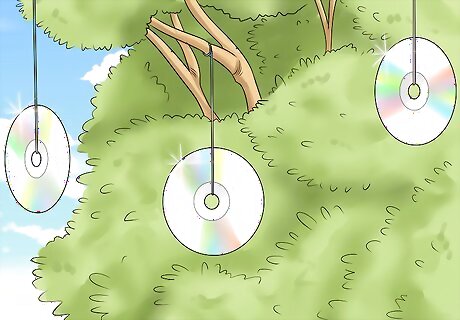
The shiny reflections scare owls away from your coop. Tie strings around the inside holes of old CDs and hang them up in close proximity to each other around common owl locations. The reflection of the sun from the CDs is a visual deterrent, while the sounds of them clicking against each other is a sound deterrent. Hang them up in a way that their clicking sounds vary in duration, sequence, and frequency for the best results. Keep an eye out for the spots that you see owls frequent the most and focus your efforts on these locations. Avoid using mirrors, as they can start fires.
Contact state and federal wildlife services.

A specialist can give you tips or help relocate a predator. As a last resort, you can contact wildlife services to help you identify problems that are drawing owls to your chickens. They can recommend prevention tips for your flocks and if you're interested in killing or relocating any predators, you must speak to local wildlife services first. While some states have a Wildlife Services program part of the U.S. Department of Agriculture’s Animal and Plant Health Inspection Service, others have state agencies. Find regional and state contacts here: https://www.usa.gov/federal-agencies/fish-and-wildlife-service. For countries outside of North America, search for local animal shelters. For example, Germany has the largest animal sanctuary in Europe called the Falkenberg Animal Home, while Australia has the Animal Welfare League of Queensland. Some areas of the world, like Ukraine, Greece, Egypt and Romania, do not have well-established policies to address animal control and care.



















Comments
0 comment